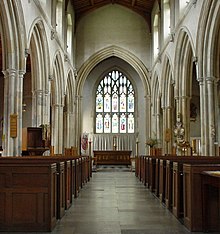St Giles-without-Cripplegate
| St Giles-without-Cripplegate | |
|---|---|
 Current photo of St Giles-without-Cripplegate | |
 | |
| Address | City of London |
| Country | United Kingdom |
| Denomination | Church of England |
| Architecture | |
| Heritage designation | Grade I listed building |
| Style | perpendicular gothic |
| Administration | |
| Diocese | London |
St Giles-without-Cripplegate is a Church of England church in the City of London, located on Fore Street within the modern Barbican complex.[1] When built it stood without (that is, outside) the city wall, near the Cripplegate. The church is dedicated to St Giles, patron saint of beggars and the handicapped. It is one of the few medieval churches left in the City of London, having survived the Great Fire of 1666.[2]
History
There had been a Saxon church on the site in the 11th century but by 1090 it had been replaced by a Norman one. In 1394 it was rebuilt in the perpendicular gothic style.[3] The stone tower was added in 1682.
[1545] The xii day of September at iiii of cloke in the mornynge was sent Gylles church at Creppyl gatte burnyd, alle hole save the walles, stepull, belles and alle, and how it came God knoweth.
The church has been badly damaged by fire on three occasions: In 1545, in 1897[4] and during an air raid of the Blitz of the Second World War on the night of 24 August 1940.[5] German bombs completely gutted the church but it was restored using the plans of the reconstruction of 1545. A new ring of twelve bells was cast by Mears and Stainbank in 1954, and this was augmented with a sharp second bell cast in 2006 by the Whitechapel Bell Foundry.[6]
The church was designated a Grade I listed building on 4 January 1950.[7]
Notable people associated with the church

- John Field, curate of the church, c. 1570
- John Foxe, author of the Book of Martyrs, surrogate for Crowley c. 1565 and buried in the church, 1587
- Robert Crowley, rector of St Giles's, friend of Foxe, printer, poet, social gospeller, and Protestant polemicist, buried in the church, 1588
- Thomas Deloney
- Lancelot Andrewes, rector of the church after Crowley
- Sir Martin Frobisher, captain who fought against the Spanish Armada, buried in the church, 1594
- Nathaniel Eaton, first schoolmaster of Harvard College, christened, 1610
- Oliver Cromwell, military commander and Lord Protector of England during the Commonwealth, married in the church, 1620
- Nicholas Tooley, Shakespearean Actor, Sharer of Globe Theatre Buried 5 June 1623
- John Speed, author of the Theatre of the Empire of Great Britaine, buried in the church, 1629
- John Milton, author of Paradise Lost, buried in the church, 1674
- John Bunyan, author of Pilgrim's Progress, attended the church
- Daniel Defoe, author of Robinson Crusoe, died in the parish, 1731
- Rick Wakeman, keyboardist who recorded his track "Jane Seymour" (from The Six Wives of Henry VIII) and Yes track "Close to the Edge"[8] at the church
- Roger Townshend was buried in the church in 1590.
Layout of the church

- John Milton buried here in 1674
- The altar from St. Luke's, Old Street, which was dismantled in the 1960s due to subsidence.
- The east window. Designed by the Nicholson Studios, following the pattern of the original medieval window.
- Sedilia (where the priest sat) and piscina of the medieval church.
- Display cabinet containing the historic treasures of Cripplegate.
- John Foxe, author of "The Book of Martyrs" is buried here.
- Plaque commemorating Sir Martin Frobisher, explorer and sea Captain.
- Bust of John Speed, map maker and historian.
- Statue of John Milton by Horace Montford[9]
- The organ. From St. Luke's, Old Street[10]
- Bust of Daniel Defoe, author of "Robinson Crusoe" and John Milton.
- Busts of Oliver Cromwell and John Bunyan, author of "Pilgrim's Progress".
- Portrait of Dr. William Nicholls, the first Rector of St. Luke's Church and Vicar of St. Giles'.
- The West Window – shows the coats of arms of the Archbishop of Canterbury, the Bishop of London, Milton, Cromwell and Frobisher.
- The font – from St. Luke's Church.
- The Cripplegate Window which celebrates the centenary of the charity The Cripplegate Foundation.
- Bust of Sir William Staines, Lord Mayor of London in 1801.[11]
51°31′7.38″N 0°5′38.55″W / 51.5187167°N 0.0940417°W
See also
References
- ^ "The City of London Churches" Betjeman,J Andover, Pikin, 1967 ISBN 0-85372-112-2
- ^ "The London Encyclopaedia" Hibbert,C;Weinreb,D;Keay,J: London, Pan Macmillan, 1983 (rev 1993,2008) ISBN 978-1-4050-4924-5
- ^ "The Old Churches of London" Cobb,G: London, Batsford, 1942
- ^ "The Visitors Guide to the City of London Churches" Tucker,T: London, Friends of the City Churches, 2006 ISBN 0-9553945-0-3
- ^ History of St Giles' without Cripplegate
- ^ Love's Guide to the Church Bells of the City of London
- ^ Historic England. "Details from listed building database ({{{num}}})". National Heritage List for England. accessed 23 January 2009
- ^ Mettler, Mike. "Total 5.1 Mass Retain: Steven Wilson on Mixing Yes' Close to the Edge in Surround Sound". The Sound Board. Retrieved 28 February 2014.
- ^ "London:the City Churches” Pevsner,N/Bradley,S New Haven, Yale, 1998 ISBN 0-300-09655-0
- ^ Pearce,C.W. “Notes on Old City Churches: their organs, organists and musical associations” London, Winthrop Rogers Ltd 1909
- ^ St Giles's Church Guide
